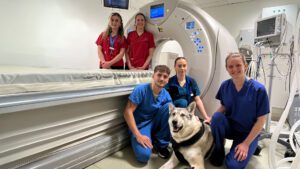Summary
Cavalier King Charles spaniels (CKCS) are notable among dog breeds for their high rate of Chiari-like malformation (CM—characterised by indentation of the cerebellum by the supraoccipital bone and/or herniation of a part of the cerebellum through the foramen magnum (Cappello and Rusbridge 2007)) and syringomyelia (SM— fluid-filled cavities within the spinal cord (syringes) (Rusbridge and others 2000, Lu and others 2003). The cause of this painful and heritable disease complex (Rusbridge and Knowler 2004, Lewis and others 2010) has been attributed to a volume mismatch between the caudal cranial fossa (CCF) and brain parenchyma contained within, mediated by crowding of hindbrain parenchyma and disturbance to cerebrospinal fluid flow dynamics in the caudal occipital region of the skull (Levine 2004, Rusbridge and others 2006). Although the occipital bones of CKCS appear to be malformed (Dewey and others 2004, Rusbridge and Knowler 2006, Carrera and others 2009), previous studies that investigated a possible association between reduced CCF volume and CM/SM yielded inconsistent results (Couturier and others 2008, Carrera and others 2009, Carruthers and others 2009, Cerda-Gonzalez and others 2009, Schmidt and others 2009, Driver and others 2010a, b). Furthermore, when CKCS were compared with other small breed dogs (SB), the CCF was appropriate in size but contained parenchyma that was disproportionately large (Cross and others 2009), suggesting that the aetiology of CM/SM in CKCS may be related to increased growth of the hindbrain. The authors of this communication recently reported that CKCS have a relatively larger cerebellum than SB and labradors (LD), and also found that in CKCS there is an association between the development of SM and increased cerebellar volume (Shaw and others 2012). However, this study also showed that increased cerebellar volume was associated with increased crowding in the caudal occipital region, in contrast with the other breeds in which caudal cerebellar crowding was independent of increased cerebellar volume. These are interesting findings as they suggest a multifactorial aetiology for CM/SM in CKCS, dependent on the cumulative effects of increased cerebellar volume and a CCF which does not reach a commensurate size. Here, we report that the morphology of the canine skull is affected by variation in hindbrain volume. Important differences exist between CKCS, SB and LD that are pertinent to the pathological mechanisms of CM/SM. Our first hypothesis is that the caudal part of the CCF is relatively smaller in CKCS than in other breeds of dog, and there is an increase in the volume in other part(s) of the CCF. Our second hypothesis is that there is an association between SM in CKCS and reduced volume of the caudal part of the CCF. Our third hypothesis is that the volume of the caudal part of the CCF in CKCS is insensitive to variation in the relative hindbrain volume, and there is increased sensitivity in other part(s) of the CCF. A retrospective study of MRI scans of CKCS, SB and LD was performed. Methods for selecting individuals, performing scans, constructing 3D models of intracranial structures and partitioning the CCF and its contents are described in our previous study (Shaw and others 2012). However, in the present study, we partitioned the CCF into three compartments (pars rostralis, pars media and pars caudalis) for volumetric analysis (Fig 1). These parts were chosen to represent the volumes bounded by the occipital bones (pars caudalis), squamous portion of the temporal bone (pars media) and tentorium cerebelli (pars rostralis). The volumes were expressed as percentages of the total skull volume (the sum of the volumes of the CCF and the rostrotentorial compartment). Hindbrain volume (defined as the volume of parenchyma in the CCF) was expressed as a percentage of the overall brain volume (the sum of CCF parenchyma volume and rostrotentorial parenchyma volume).











